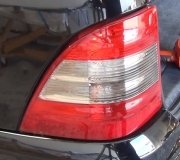Hi guys. I suspect you are both right about the ignition switch. Start by measuring the voltage on both sides of fuses 14 and 15 inside the car. They are both 10 amp, red fuses. 14 feeds the radio and 15 feeds the combination flasher unit and the wiper switch. If you cannot get your voltmeter or test light probe on the fuse terminals, there are two tiny holes on top of each fuse to poke into for test points.
If you find zero volts on both fuses you have a burned ignition switch contact and possibly a melted/overheated pair of terminals in the switch connector. Remove the steering column covers so you can back-probe the switch terminals. You will find twelve volts on terminal seven, a sixteen gauge red wire. That circuit has to be good if the starter works and the engine runs. Next, check terminal 8, a 16 gauge black/white wire. There should be twelve volts when the ignition switch is in the "run" or "acc" position. If you find that voltage missing you can double-check by jumping those two terminals with a stretched out paper clip or cotter pin. If the bad circuits start working, replace the switch and check those terminals for overheating. If the connector is melted, you can cut the two terminals out of the plastic and slide in two new ones individually. Cut off about four inches of the old wires. They will be hardened from being overheated and will be impossible to solder to. Splice in new pieces of wire, be sure there are no sharp points of wire sticking up, cover them with heat-shrink tubing, (electrical tape will unravel into a gooey mess), attach universal crimp-type terminals but also solder them for a better connection, then plug them in after the connector has been plugged in. Be sure the new terminals fit tightly. Looseness presents a small amount of resistance which causes heat buildup and that heat promotes a worse connection and more heat until the same problem occurs.
The bad contact usually originates inside the switch at the contacts then the heat migrates out to the terminals. If the connector is not melted and you are tempted to forgo replacing the terminals, be sure to inspect them very closely for discoloration. For minor darkening you might get away with using a pick to push in beside each terminal to squeeze them tighter. If they are blackened, replace them, otherwise you will be doing the job again soon. Black terminals have lost their spring tension even though you might think you cleaned up their contact points with sandpaper. The heat caused by the poor connections will migrate inside the switch and degrade the new contacts.
Sunday, November 20th, 2011 AT 7:58 PM



